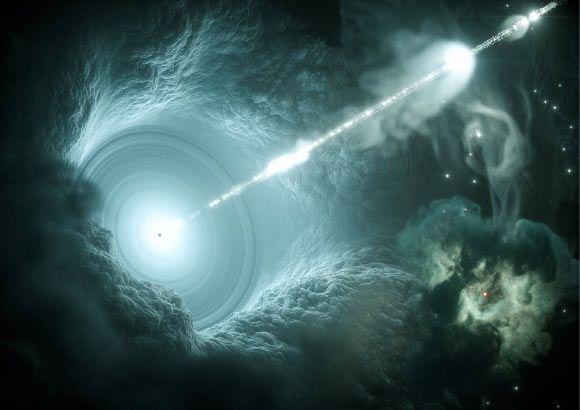Astronomers have discovered a blazar — a quasar with a jet aligned along our line of sight — at redshift of 7. Named VLASS J041009.05-013919.88, this object is the most distant blazar ever identified, providing a rare glimpse into the epoch of reionization when the Universe was less than 800 million years old.

An artist’s impression of a blazar. Image credit: DESY / Science Communication Lab.
VLASS J041009.05-013919.88 (J0410-0139 for short) is powered by a black hole with a mass of 700 million solar masses.
Multi-wavelength observations show that its radio variability, compact structure, and X-ray properties identify it as a blazar with a jet aligned toward Earth.
The discovery of J0410-0139 implies the existence of a much larger population of similar jetted sources in the early Universe.
These jets likely enhance black hole growth and significantly affect their host galaxies.
“The fact that J0410–0139 is a blazar, a jet that by chance happens to point directly towards Earth, has immediate statistical implications,” said Dr. Eduardo Bañados, an astronomer at the Max Planck Institute for Astronomy.
“As a real-life analogy, imagine that you read about someone who has won $100 million in a lottery.”
“Given how rare such a win is, you can immediately deduce that there must have been many more people who participated in that lottery but have not won such an exorbitant amount.”
“Similarly, finding one active galactic nucleus with a jet pointing directly towards us implies that at that time, there must have been many active galactic nuclei in that period of cosmic history with jets that do not point at us.”
“Where there is one, there’s one hundred more,” said Dr. Silvia Belladitta, also from the Max Planck Institute for Astronomy.
Observations with instruments such as NSF’s Very Large Array, NSF’s Very Long Baseline Array, NASA’s Chandra X-ray Observatory, and the Atacama Large Millimeter/submillimeter Array (ALMA) indicate that J0410-0139 exhibits radio emission amplified by relativistic beaming, a hallmark of blazars.
Its spectrum also confirms stable accretion and emission regions typical of active black holes.
This discovery raises questions about how supermassive black holes grow so rapidly in the Universe’s infancy.
Models may need to account for jet-enhanced accretion or obscured, super-Eddington growth to reconcile this finding with the known black hole population at such high redshifts.
“This blazar offers a unique laboratory to study the interplay between jets, black holes, and their environments during one of the Universe’s most transformative epochs,” said Dr. Emmanuel Momjian, an astronomer at NSF’s National Radio Astronomy Observatory.
“The alignment of J0410-0139’s jet with our line of sight allows astronomers to peer directly into the heart of this cosmic powerhouse.”
“The existence of J0410-0139 at such an early time suggests that current radio surveys might uncover additional jetted quasars from the same era.”
“Understanding these objects will illuminate the role of jets in shaping galaxies and growing supermassive black holes in the early Universe.”
The results appear in two papers (paper #1 and paper #2) in the journal Nature Astronomy and the Astrophysical Journal Letters.
_____
E. Bañados et al. A blazar in the epoch of reionization. Nat Astron, published online December 17, 2024; doi: 10.1038/s41550-024-02431-4
Eduardo Bañados et al. 2025. [C ii] Properties and Far-infrared Variability of a z = 7 Blazar. ApJL 977, L46; doi: 10.3847/2041-8213/ad823b

